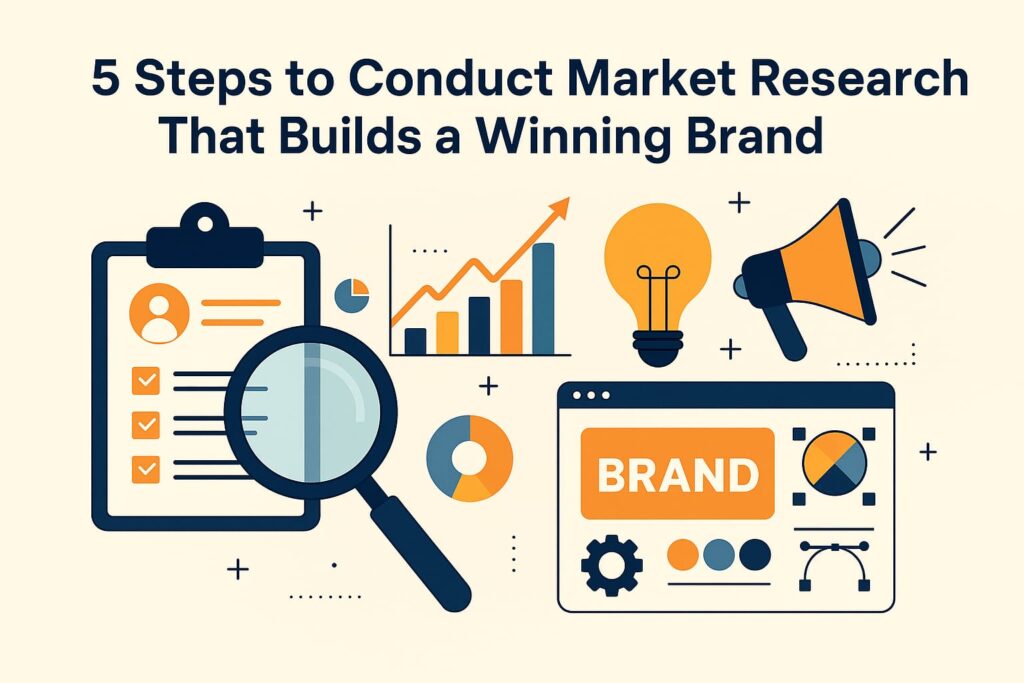Table of Contents
Introduction
In today’s highly competitive business environment, creating a successful brand doesn’t happen by chance. It requires intentional planning, sharp strategy, and above all — deep insights into your target market. That’s where market research plays a pivotal role. Market research is more than a preliminary step; it’s the foundation upon which all your branding efforts are built.
Without understanding your audience, competitors, and market landscape, even the most creative branding strategies can fall flat. In this blog, we’ll walk you through 5 essential steps to conduct meaningful market research that empowers your brand to connect, differentiate, and thrive. Whether you’re building a brand from scratch or refining an existing identity, these actionable steps will help you make informed decisions and create a brand that resonates.

1. Define Your Goals and Objectives
Before diving into data collection, clearly define what you want to achieve through market research. Are you trying to identify a new target audience? Understand why your competitors are performing better? Or improve brand positioning? Your objectives will determine the type of research (quantitative or qualitative) and methods you’ll use. Being focused from the start helps ensure the research provides actionable insights.
2. Identify and Understand Your Target Audience
Your brand needs to speak directly to the people you’re trying to reach. Use surveys, focus groups, social listening, and customer interviews to build detailed personas of your ideal customers. Understand their demographics, motivations, needs, purchasing behavior, and pain points. This human-centered approach ensures your brand messaging, visuals, and tone are relatable.
Visual: 5 amazing steps to design a brand logo
https://writer.delitsmotionpicture.com/designing-impactful-visual/
3. Analyze Your Competitors
One of the most valuable elements of market research is competitive analysis. Identify your direct and indirect competitors, study their branding, value propositions, and customer engagement tactics. What’s working for them? Where are they falling short? Tools like SWOT analysis (Strengths, Weaknesses, Opportunities, Threats) can help you find gaps in the market your brand can fill.

How to do market research in 5 simple steps
4. Use the Right Tools and Methods
Effective market research combines both qualitative and quantitative methods. Use tools like Google Trends, SEMrush, or SurveyMonkey to collect data. Leverage CRM insights, website analytics, and social media engagement to study behavior trends. Choose methods based on your goals — interviews for in-depth opinions, surveys for broad data, and focus groups for exploratory feedback.
5. Interpret the Data and Take Action
Collecting data is only half the battle. The real power of market research lies in how you interpret the results and implement changes. Look for patterns and themes that indicate opportunities or threats. Does your audience prefer emotional branding or informational content? Is there a demand your competitors haven’t addressed? Use this analysis to guide your brand’s voice, messaging, visual identity, and product positioning.
ALSO READ
Awesome Branding – Content writer
Bonus Step: Monitor Trends and Stay Adaptive
In a dynamic business landscape, staying ahead means not just researching once but continually monitoring shifts in customer behavior, emerging technologies, and competitor strategies. Use trend-tracking tools like Google Alerts, social media trend analytics, and industry newsletters to keep your brand agile. This step ensures you are not just reacting to market shifts but proactively evolving. Adaptability is crucial for long-term brand success.
Bonus Step: Monitor Trends and Stay Adaptive
In a dynamic business landscape, staying ahead means not just researching once but continually monitoring shifts in customer behavior, emerging technologies, and competitor strategies. Use trend-tracking tools like Google Alerts, social media trend analytics, and industry newsletters to keep your brand agile. This step ensures you are not just reacting to market shifts but proactively evolving. Adaptability is crucial for long-term brand success.
Common Mistakes to Avoid During Market Research
Even with the right tools, many brands make critical mistakes during market research. Here are a few to watch out for:
– Skipping qualitative insights: Data is important, but understanding the emotions behind decisions is equally crucial.
– Relying solely on secondary research: Primary data from your actual customers often provides fresher, more relevant insights.
– Ignoring negative feedback: It’s tempting to disregard criticisms, but they often highlight your biggest opportunities for improvement.
– Using outdated data: Make sure your sources are current and relevant to your present goals.
The Role of Emotion in Market Research for Branding
Brands that form emotional connections with customers are far more likely to earn loyalty. Market research should include emotional drivers: what makes your audience feel confident, inspired, safe, or excited? Emotional intelligence in brand messaging can increase customer retention and word-of-mouth referrals. Methods like storytelling-based interviews and sentiment analysis tools can uncover these emotional insights.
Tools and Resources to Help You Get Started
Here’s a list of tools and platforms that can make your market research more effective:
– **Google Forms / SurveyMonkey**: For creating surveys.

– **Hotjar / Crazy Egg**: To observe website visitor behavior.
– **BuzzSumo**: To track content trends and competitor engagement.
– **SEMrush / Ubersuggest**: To analyze keyword and SEO trends.
– **Qualtrics**: Enterprise-level market research and customer experience platform.
– **Social Mention**: To monitor brand mentions across social media.
Integrating Research Insights into Brand Messaging
Once you have collected and analyzed your market research data, the next crucial step is integrating those insights into every aspect of your brand messaging. Begin by revisiting your brand’s core value propositions and see how they align with the needs and desires uncovered in your research. Craft messaging frameworks that highlight the benefits most valued by your audiences—whether it’s convenience, sustainability, innovation, or emotional connection.
Develop key message pillars and tailor them for different channels. For instance, on social media, you might focus on emotional storytelling that resonates with younger demographics, while your email campaigns could emphasize data-driven benefits for decision-makers. Consistency across touchpoints reinforces your credibility, but nuanced tweaks ensure each message meets the audience where they are.

Integrating Research Insights into Brand Messaging
Once you have collected and analyzed your market research data, the next crucial step is integrating those insights into every aspect of your brand messaging. Begin by revisiting your brand’s core value propositions and see how they align with the needs and desires uncovered in your research. Craft messaging frameworks that highlight the benefits most valued by your audiences—whether it’s convenience, sustainability, innovation, or emotional connection.
Develop key message pillars and tailor them for different channels. For instance, on social media, you might focus on emotional storytelling that resonates with younger demographics, while your email campaigns could emphasize data-driven benefits for decision-makers. Consistency across touchpoints reinforces your credibility, but nuanced tweaks ensure each message meets the audience where they are.
Integrating Research Insights into Brand Messaging
Once you have collected and analyzed your market research data, the next crucial step is integrating those insights into every aspect of your brand messaging. Begin by revisiting your brand’s core value propositions and see how they align with the needs and desires uncovered in your research. Craft messaging frameworks that highlight the benefits most valued by your audiences—whether it’s convenience, sustainability, innovation, or emotional connection.
Develop key message pillars and tailor them for different channels. For instance, on social media, you might focus on emotional storytelling that resonates with younger demographics, while your email campaigns could emphasize data-driven benefits for decision-makers. Consistency across touchpoints reinforces your credibility, but nuanced tweaks ensure each message meets the audience where they are.

Conclusion: Turning Research Into Branding Power
The ultimate goal of market research is not just to collect data, but to transform insights into brand-building strategies. From your brand voice to your visual identity, everything should be informed by the market you serve. Research doesn’t replace creativity — it sharpens it. By making research a continuous, foundational practice, you ensure your brand evolves with its audience, gains a competitive edge, and remains relevant in a noisy marketplace.
Whether you’re a startup or an established business, investing time and energy into market research will always pay off. It builds not only smarter strategies, but also stronger, more human brands.
Final Thoughts
Market research isn’t a one-time activity; it’s an ongoing process that evolves as your brand and market change. By understanding your customers, studying your competitors, and continuously gathering insights, you’ll build a brand that’s not only memorable but also meaningful to the people you serve. These five steps form a reliable blueprint to ensure your branding efforts are grounded in real-world data and audience needs.
At its core, market research empowers you to stop guessing and start connecting. And when your brand truly connects — it wins.